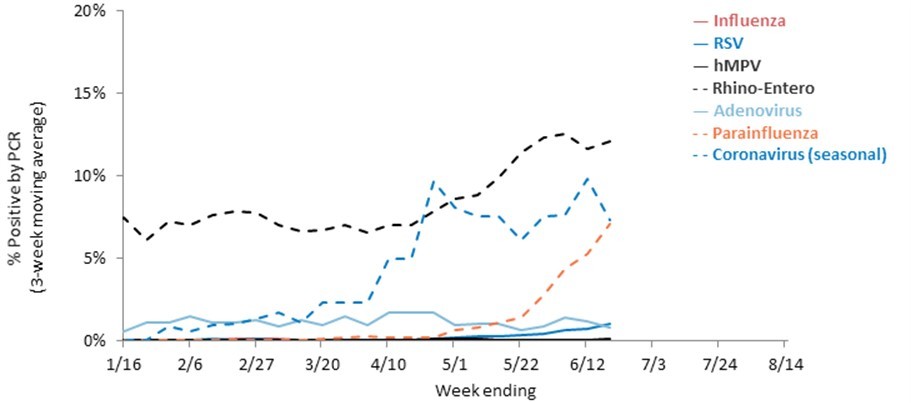|
Wisconsin DHS Health Alert #32
Increased circulation of Non-COVID-19 respiratory viruses among Children and Adults in Wisconsin
Bureau of Communicable Diseases
June 28, 2021
Main Points
- DHS surveillance data indicate a significant increase in non-COVID respiratory illnesses during June 2021, specifically respiratory syncytial virus (RSV), parainfluenza and seasonal coronaviruses. It is unusual to see high incidence of these viruses at this time of year.
- Increases in hospitalizations for these respiratory illnesses, especially among children, have been noted in multiple locations across Wisconsin.
- Everyday actions that prevent the spread of COVID-19, can also prevent the spread of other respiratory illnesses. Wash your hands often with soap and water, cover coughs and sneezes, and stay home when you are sick.
- People who have symptoms should stay home to prevent the potential spread of illness, especially in summer camps, child care programs, long-term care facilities, and other settings where close contact is likely.
- Clinicians should continue to prioritize testing all patients with respiratory illness for COVID-19. Additional testing for other respiratory viruses with a multiplex respiratory virus panel using RT-PCR, is indicated for patients who test negative for COVID-19.
Dear Colleagues,
DHS surveillance data indicate a significant increase in June of non-COVID respiratory illnesses. Positive tests for respiratory syncytial virus (RSV), parainfluenza and seasonal coronaviruses have all increased in comparison to prior months. These viruses are a major cause of severe lower respiratory infection in young children and older adults. The populations most at risk for these illnesses are children in day care settings, older adults in long-term care, and people with weakened immune systems.
In Wisconsin, the activity of these viruses has increased over the past few weeks to levels higher than would typically be expected for this time of year, based on data reported to the Wisconsin State Laboratory of Hygiene and the National Enteric and Respiratory Virus Surveillance System (Figure 1). Data from syndromic surveillance of hospital emergency departments also indicate a significant increase in influenza-like illness among children less than five years old.
RSV and seasonal coronaviruses circulate in a seasonal manner during late fall and winter, while parainfluenza circulates in spring and early summer. Mitigation efforts used to fight the COVID-19 pandemic helped to prevent transmission of these seasonal respiratory viruses this past year, so these viruses circulated at unprecedented low levels in 2020.
Respiratory illnesses other than COVID-19, such as RSV, parainfluenza virus, and seasonal coronavirus can cause symptoms such as fever, cough, and runny nose. In young children, older adults, and people with underlying medical conditions, they can also cause severe pneumonia. In rare cases, neurologic symptoms including gait disturbance have been reported with parainfluenza virus infection.
It is vital to continue testing for these respiratory illnesses using the virus panel RT-PCR, in addition to testing for COVID-19. Remember that a COVID-19 vaccine does not necessarily preclude someone from getting COVID-19 and does not protect them from RSV, seasonal coronaviruses, and parainfluenza.
Figure 1. Positivity of Respiratory Specimens by PCR at Wisconsin Laboratories
 Recommended Actions
Everyday actions that prevent the spread of COVID-19, can also prevent the spread of other respiratory illnesses. Wash your hands often with soap and water, cover coughs and sneezes, and stay home when you are sick.
- People who have symptoms should stay home to prevent the potential spread of illness, especially in summer camps, child care programs, long-term care facilities, and other settings where close contact is likely.
- Clinicians should continue to prioritize testing all patients with respiratory illness for COVID-19. Additional testing for other respiratory viruses with a multiplex respiratory virus panel using RT-PCR, is indicated for patients who test negative for COVID-19.
- Hospitals experiencing increased incidence of children hospitalized and admitted to the ICU should notify the DHS via email at DHSDPHBCD@wi.gov or by calling 608-267-9003.
Ryan Westergaard, MD, PhD, MPH
Chief Medical Officer and State Epidemiologist for Communicable Diseases
Wisconsin Department of Health Services
About the COVID-19 Health Alert Network
The content of this message is intended for public health and health care personnel and response partners who have a need to know the information to perform their duties. The HAN will be the primary method for sharing time-sensitive public health information with clinical partners during the COVID-19 response. Health care providers and other officials can subscribe and unsubscribe using their preferred email address at the DHS COVID-19 website.
I received your message
|